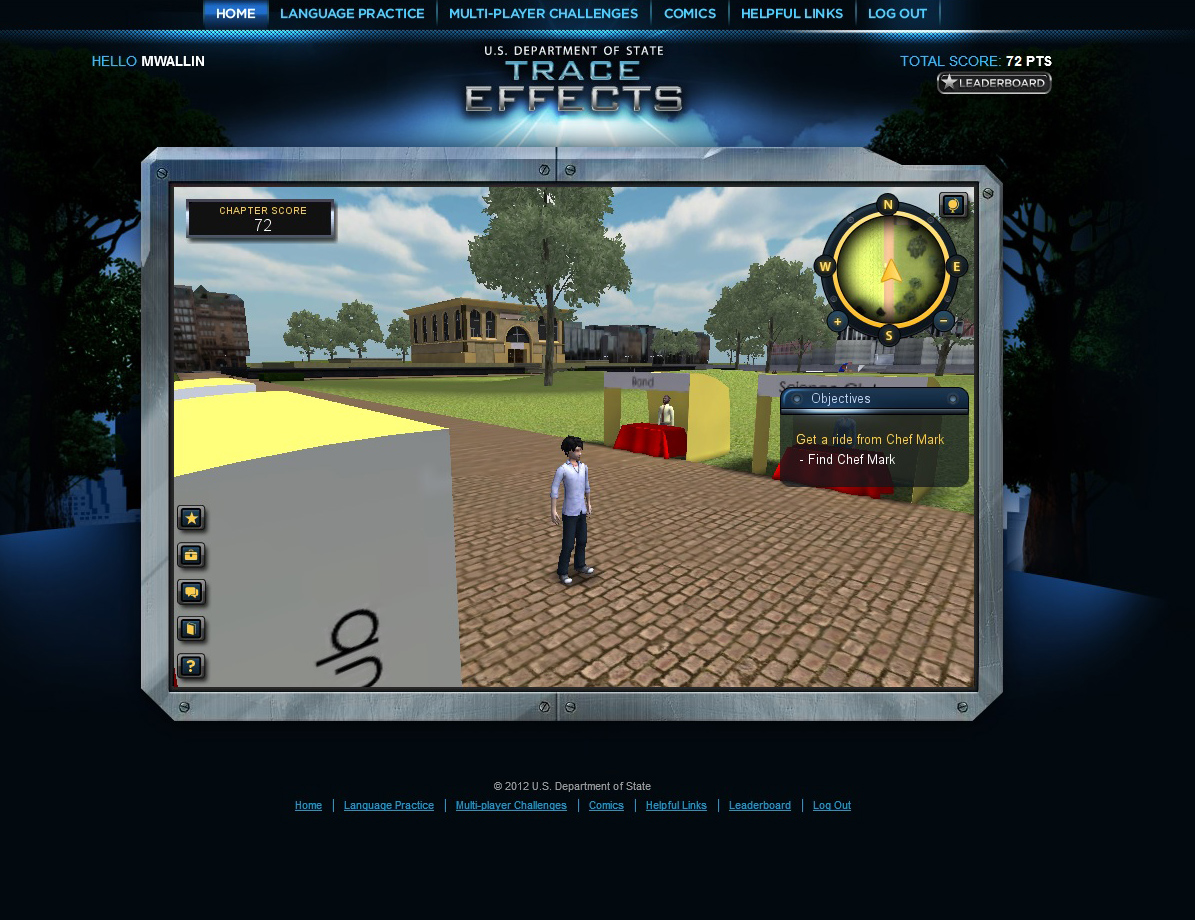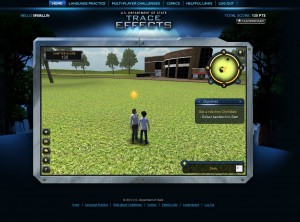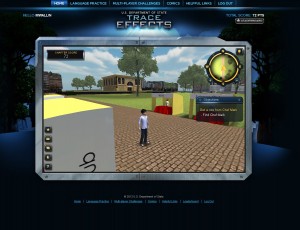
Trace Effects: The State Department’s English-Teaching Video Game
In recent days, there have been a few news stories and speeches given making reference to “Trace Effects,” a new video game the State Department has been using to teach English overseas.
In order to better understand what Trace Effects actually is, I took about 30 minutes to play the game and see how it works.
While the attractiveness of video games has been growing over the years and is reaching new audiences, we must also consider some of the key factors that make gaming attractive to the age range that the State Department is targeting. Today’s youth are becoming more and more accustomed to expecting big returns from video games, and Trace Effects is rather muted.
With the exception of the plot, I review some of the key factors of attractiveness below.
Platform:
The game is browser based, and requires the installation of a plugin called “Unity Web Player.” I do not know the process by which the game designers chose this plugin, but it would seem to me that a more “common” plugin like Flash or Silverlight would have its benefits, but might require dropping the 3D environment.
Given the prevalence of mobile devices, a mobile app may be more effective in reaching a wider audience under certain conditions. It does not work on an Android based browser.
The key question regarding platform choice is who and when the State Department is trying to reach. If the answer is children in schools, this seems very appropriate. However, if it is children outside of school, other platforms may potentially be more suitable—provided Trace Effects has enough of an entertainment draw to captivate an audience outside of the classroom, and this is the problem.
Entertainment Factor:
This is the type of game most likely to be used in schools—which has benefits as well as drawbacks. It is far from being the fast-paced reflex oriented type of game play to which many young people are accustomed, making it unlikely to be used at home. While it may be useful for schools, it is doubtful that many would choose to play in a non-academic setting. Certainly, there is a role for “school” games, as any American student who grew up with The Oregon Trail can attest.
There is also little consequence for failure. In nearly every successful video game, there has always been a consequence for losing, “dying,” or otherwise failing—whichever tag seems most appropriate. This fully applies to nonviolent games, such as Tetris, where you can most definitely fail, and the risk of failing is what motivates you to do better. In other words, the games are challenging. In Trace Effects, it appears you cannot really fail—while you cannot “die of dysentery,” you can lose points for making mistakes.
The bottom line is it’s not quite “fun” enough to be a game, and this seems to be Trace Effects’ biggest handicap.
Interface:

One mission involved delivering a sandwich to “Sam,” who was supposed to be wearing a black shirt. Giving the sandwich to a “Sam” in a white shirt resulted in losing points, even though she loved the sandwich.
The game uses a standard keyboard layout that most young PC gamers should be familiar with. The interface overall is simple and intuitive.
Most interaction with the in-game environment occurs as a result of reaching an “action point,” where you are given a series of options in a selection box. Points are accrued for interacting with people, and extra points are earned for being cordial and polite.
Graphics:
The game uses a third-person 3D interface typical of many modern video games. The quality of graphics is nothing to write home about (equivalent to PC gaming from 15+ years ago), but presents an environment that is high enough quality to be tolerable while still usable on a low-end computer with a basic broadband connection. The ensures that the widest variety of users can successfully access the game. However, it should be noted that many mobile games do exceed the visual appeal of Trace Effects.
Conclusion:
Overall, if the mission of the Trace Effects project is purely to be an English teaching tool, it may be successful. But if the lure of Trace Effects is based on its format as a video game, it may prove a bit lacking outside of school settings. It’s a great idea in concept, but will likely need a great deal of refinement to be effective.
For instance, some of the physical interactions between the characters in the game are awkward and English phrasing tends to be unintentionally humorous. For instance when attempting to “give” your ID to a person requesting it, rather than “show” them the ID, the game points out you are in error, and a character verbally states, “Don’t give it to me, just show it to me.” To juvenile minds, this type of phrasing may be seen as suggestive or lewd.
Echoing my sentiments about entertainment, in an interview with Voice of America, Sandra Calvert, of the Children’s Digital Media Center at Georgetown University, pointed out that the text-response nature of the game may be problematic to kids who are accustomed to “action” oriented games, and the plot may be lost. Simply put, the game needs to be exciting and fun—and it is neither. However, as a gamer, I must give kudos to the programmers for leaving in the ability to “bunny hop” your way around the map.
The draw from competing entertainment products is ultimately an issue that is likely to lure kids away from Trace Effects. It is certainly possible to create entertaining products out there that still have educational benefits: i.e. Angry Birds Space, which was developed in coordination with NASA. However, with such a pointed goal of English education, it is unclear if this is the best approach.
Yet video games are not the only medium that faces the problem of competition. Public diplomacy efforts face this issue across all mediums. The trick is to find ways to make the product and the message truly appealing to the target audience and understand that the medium alone does not serve this purpose.








[…] Trace Effects: The State Department’s English-Teaching Video Game […]